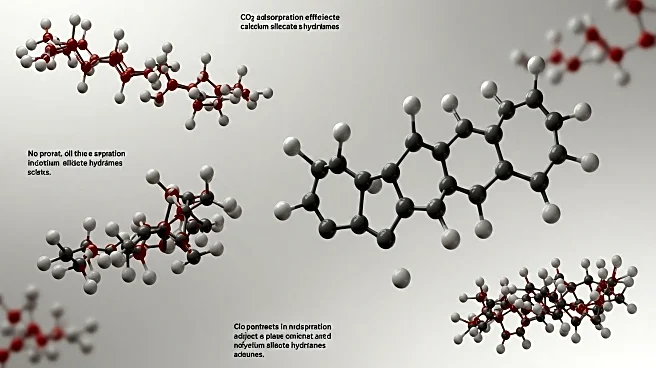What's Happening?
Recent research has delved into the mechanisms of CO2 adsorption in calcium silicate hydrates (C-S-H), focusing on the role of surface chemistry and pore water fluctuations. The study highlights how varying relative humidity (RH) and the calcium-to-silicon (Ca/Si) ratio in C-S-H influence CO2 adsorption. It was found that CO2 adsorption increases with water content, reaching a peak at specific RH levels before declining sharply when water saturation exceeds a critical threshold. The research utilized slit pore models to simulate CO2 adsorption processes, revealing that higher Ca/Si ratios enhance CO2 adsorption capacity under low water coverage conditions. However, under high water coverage, the adsorption dynamics become more complex, with capillary condensation playing a crucial role in CO2 intake.
Why It's Important?
Understanding CO2 adsorption in C-S-H is significant for advancing carbon capture and storage technologies, which are vital in mitigating global warming. The findings could lead to more efficient methods of permanently storing anthropogenic CO2, thereby reducing carbon emissions. Industries involved in construction and materials science may benefit from these insights, as they could inform the development of more sustainable building materials. Additionally, the research underscores the importance of optimizing material properties to enhance CO2 adsorption, potentially influencing future environmental policies and industrial practices.
What's Next?
Further research is expected to explore the surface effects on CO2 adsorption and water phase transformation within C-S-H mesopores. This includes investigating why higher Ca/Si ratios result in greater CO2 adsorption and the conditions under which capillary condensation maximizes CO2 intake. The study may prompt additional experiments to refine the understanding of CO2-water interactions and their implications for carbon storage technologies.
Beyond the Headlines
The study also touches on the broader implications of material science in environmental sustainability. By enhancing the CO2 adsorption capacity of building materials, there is potential for significant reductions in the carbon footprint of construction projects. This aligns with global efforts to transition to greener practices and could influence the cultural shift towards more environmentally conscious building standards.















